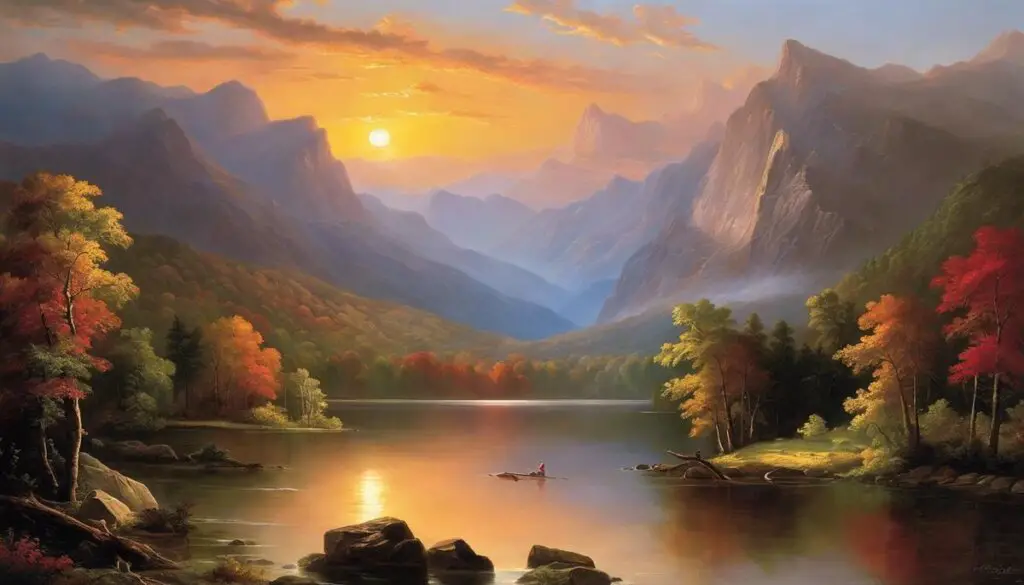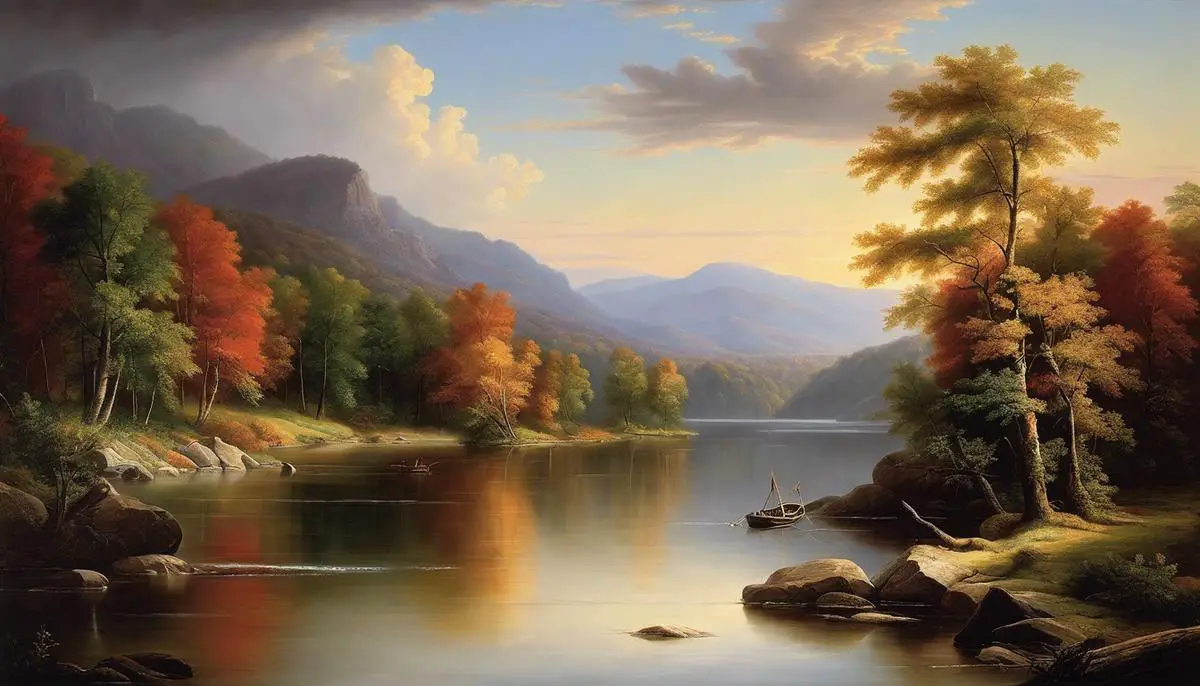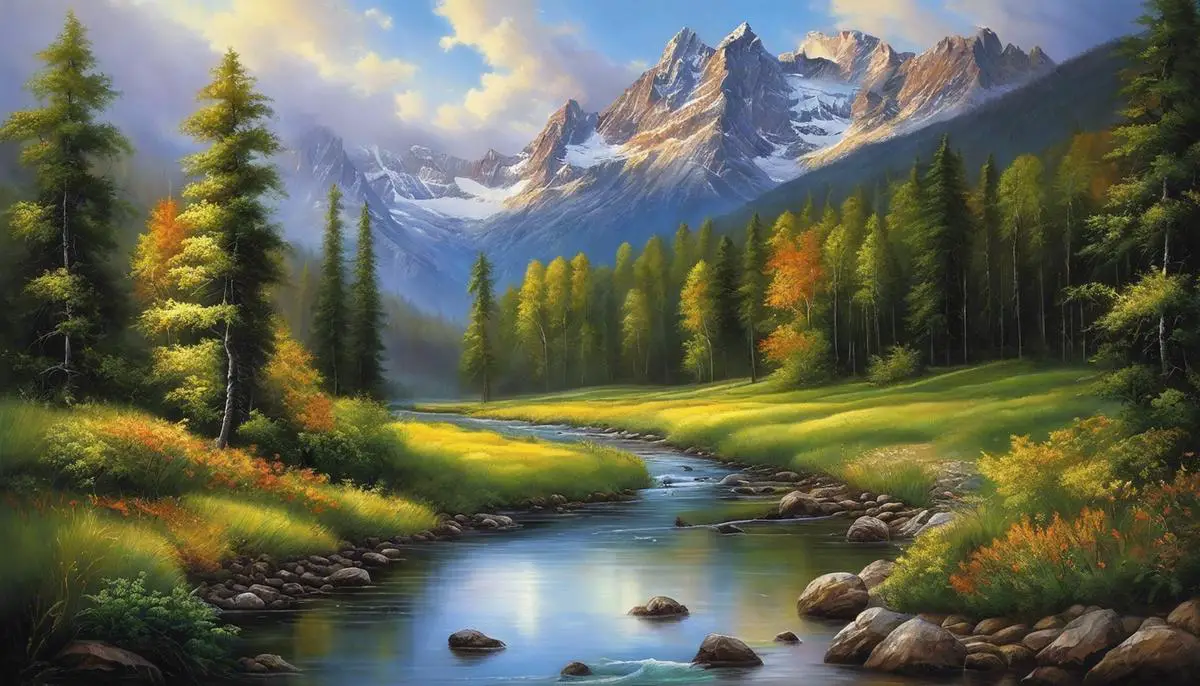Influence and Impact: Exploring Hudson River School Artists

At the heart of American romantic landscape painting, one discovers the eminent, mid-19th-century Hudson River School, which manifested a fervent interest in the contemplative depiction of nature. In the vein of the pioneering artists such as Thomas Cole and Frederick Edwin Church, this school was no ordinary institution, but rather, it was a movement, an ethos that revered the grandeur of the American wilderness. The artists, intoxicated by the sublime landscapes, championed detailed realistic portrayals, interpreting the world as a sublime manifestation. Dive with us into this comprehensive exploration that traces the origins of this momentous school, its unique artistic style and themes, as well as the profound cultural impacts and legacy it has left on the world today.
Origins and Founding Artists of the Hudson River School
In the grand tapestry of art history, one particular movement stands distinctively proud in all its rampant, raw beauty – The Hudson River School. Inspired by the iconic Hudson River Valley itself, shining rivers shrouded by towering trees and moody, contemplative skies, this 19th-century American art movement reflected a thirst for unvarnished, pristine wilderness. Indeed, does not Mother Nature serve as the grandest of all canvases?
Peeling back the layers of history, one finds the Hudson River School originated around 1850. The movement was birthed, unsuspectedly, from a small collective of painters, who found themselves entranced by the wild, emotionally evocative landscapes free from the touch of human interference. Yet, civilisation imprints upon nature too, a contrast the artists lovingly captured – wild tranquillity disturbed, for better or worse, by the advent of human progress.
Among those artists, two figures are often recognised as prominent founding members of this school – Thomas Cole and Asher Durand. The Hudson River School’s initiation, its cradle if you will, is usually credited to British-born painter Thomas Cole. His nature-focused artworks resonated with an unfolding Western romanticism, seeping across the Atlantic from Europe. Cole demonstrated an uncommon reverence for untamed landscapes, often capturing them in their most sublime, dramatic moments.
Asher Durand, on the other hand, an eminent portraitist and engraver, later shifted his focus towards landscape art under Cole’s influence. Durand’s style displayed more tranquil settings, emphasising the harmonious existence of humans within nature. A firm contributor to the movement, his work is remembered for its realist approach and illustrious detail.
Unfolding like a petal into the second generation, the Hudson River School successor was Albert Bierstadt, whose illustrious depictions of Western America are very characteristic of luminism, a striking offshoot of the Hudson River School.
This collective didn’t merely produce art for its own sake, creating visually beautiful work; their creations sought to express a deep sense of respect, reverence and a quiet plea for the conservation of untouched natural landscapes. Like a visual haiku, their work conveyed a profound message with simplicity and elegance.
The Hudson River School, resplendent in its recognition of nature’s untamed beauty, encourages each of us to view the world with wide-eyed wonder. Its enduring legacy whispers a compelling narrative of where we’ve been and offers a spectacular vista of where we might yet journey to, on this endless voyage of artistic exploration. In retrospect, isn’t that the true purpose of art? To ask questions, invite introspection and ultimately elevate our shared human experience. We, as upholders of art, owe an immeasurable debt to the great minds of the past, for paving the path we continue to walk upon today. That, perhaps, is the greatest lesson of the Hudson River School.

Artistic Style and Themes of the Hudson River School
Building upon the captivating beginnings of the Hudson River School, we journey into the evocative styles and themes that defined this significant artistic movement. This movement is famed for its striking aesthetics that deeply immersed viewers within the breathtaking marvels of nature, propelling landscape art into a new era of profound appreciation.
A notable characteristic of Hudson River School was the intricate employment of luminism. Through this distinct style, the artists of the Hudson River School were able to mesmerise their audience by effectively capturing the ephemeral play of light and shadow in their compositions. This was accomplished by infusing their art with subtly detailed brushwork and atmospheric effects that encapsulated the hushed serenity of dawn or the final, radiant glimmers of dusk.
In accessing the heart of the American landscape, the artists passionately portrayed landscapes ranging from pastoral countryside scenes to the ruthless wilderness of the mountain regions. Grand vistas captured through wide angles were frequently used, with scenes often framed by lush trees or imposing cliffs. The viewer’s perspective was frequently led towards a central point, highlighting the majesty and enormity of nature. Artistic elements such as cascading waterfalls or distant mountains were meticulously included, reminding the viewer of the stunning beauty and raw power of the natural world.
The Hudson River School was not solely bound by realistic interpretation. It also incorporated elements of romanticism, with artists presenting idealised views of the landscape to stir emotions and provoke thought. This fusion accentuated the spiritual dimension of nature, assigning it an ethereal quality which transcended the typical human experience. The artists drew upon themes of discovery, exploration, and settlement to engage with the prevalent relationship between humanity and nature.
Equally telling of the Hudson River School’s thematic resonance was its rich infusion of symbolism. The interplay between light and dark in many compositions sought to represent moral polarities, where the purity of untouched nature is contrasted with the ominous shadow of human encroachment. Also, recurring motifs such as the solitary tree, winding paths and distant voyagers were rife with spiritual metaphors.
Evoking a marvel as vast and complex as the American wilderness was no small feat, but the Hudson River School did more than just convey its elegance. Bolstered by an artistry that fused realism with romanticism, this movement offered viewers a transformative journey, employing the grandeur of nature as a springboard to contemplate deeper philosophical and moral dimensions. Such an unforgettable blend of styles and themes is what continues to distinguish the Hudson River School in the annals of artistic history.

Cultural Impact and Legacy of the Hudson River School
The Sublime Legacy of the Hudson River School: A Deeper Dive into Cultural and Aesthetic Influences
Within the intricate tapestry of art history, the Hudson River School artists are distinguished threads – colourful, dramatic, and emotional – that forever altered the fabric of American cultural identity. One cannot study their work without acknowledging the significant contribution these pioneering virtuosos made, not only within the art world, but through the cultural landscape of an evolving nation.
Acting as the artistic voice of the burgeoning 19th-century America, Hudson River School artists painted eloquent, eloquent panoramas, imbuing each canvas with the profound reverence for nature’s grandeur. Their landscapes, resonating with a harmonious relationship between humans and their natural setting, encapsulated a brand of intrinsic patriotism. Transforming bucolic countrysides, majestic mountainous regions, and vast cosmopolitan vistas into a language, the artists spoke of the nation’s strength, potential, and spirit.
Indeed, as the fountainhead of American landscape painting, the Hudson River School left an indisputable imprint. Developing the protocol, they set a benchmark for many contemporary and modern American painters to follow, essentially building the backbone of America’s artistic scene. Replete with aesthetic value and visual grandeur, a Hudson River School painting is much more than an illustrated interpretation of nature; it is a symphony of colours, light, and shadow, capturing the pulse of an era, nation, and culture.
Just as a pebble thrown in a pond creates ripples, the Hudson River School artists’ influence materially affected the cultural attitude towards conservationism. As their canvases depicted untouched wilderness with a romantic spirit, they fuelled the ongoing conservation movement, bringing a respect for Mother Nature to the forefront of public thought.
Furthermore, their distinctive treatment of light and shadow created a dance across the canvas that notably influenced the Luminist painters. Transcending beyond realistic reproductions, their portrayal of light and atmosphere brought the viewer head-on with the immortal, spiritual dimensions of the natural world. This luminary interplay, illuminated on canvas, paved the way for new artistic conversations in realism and impressionism.
In the grand scheme of art history, the Hudson River School movement introduced a new vocabulary of visual storytelling, merging the corporeal world with the profound depth of collective sentiments and ideologies. This transformative journey into a viewer’s consciousness stretched the boundaries of art, melding emotion, concept, and technique into a cohesive masterpiece.
In conclusion, the Hudson River School artists painted not just landscapes, but the beating heart of the American spirit. Their enduring legacy continues to inspire, influence, and engage, carving a triumphant path in the stream of art history that will forever celebrate their visionary contributions. Their blend of styles and themes, coupled with their profound sensitivity to light, shadow, and colour, crafted a panoramic spectrum of potent visuals, casting a stellar spotlight on the Hudson River School’s unique place in artistic history.
Vibrantly colourful, deeply impactful, and exquisitely rendered, their legacy undeniably looms large, echoing their resounding impact into the 21st century and beyond. Remembering them, we aren’t just honouring the past; we’re acknowledging the pillars upon which much of our artistic culture rests. Through their brushes, they have indeed coloured the cultural landscape of America – a resonating harmonious note continuing through the annals of time.

The Hudson River School, with its exceptional emphasis on landscapes and natural elements, significantly contributed to shaping the narrative of American visual culture, transcending the traditional bounds of art. Its visionary artists, holding a mirror to the nation’s landscapes, created a uniquely American aesthetic, leaving a lasting influence on future generations of artists. Embodying the themes of wilderness, progress, and American pastoral life, they epitomised a dialogue between man and nature, harmoniously uniting the two in each canvas. Unpacking the school’s profound cultural impact and legacy, one can truly appreciate its role as a champion of nature, an epitome of artists’ reverence for their surroundings, and an enduring testament to America’s romanticised vision of its landscapes.
Recommend0 recommendationsPublished in Uncategorized







